Removing large fallen oak limbs.
There's an oak in our woodland that has been absolutely battered by wind these last few years. Limbs that formed its canopy split and fell upside down onto the ground. They had to be dealt with.
This particular oak tree has been battered over the years. At least three sections have been split off at different time frames. One as recent as last week (absolute time reference July 2023) and the others, judging by the dryness of the wood on the floor about three to four years ago.
Here’s a large section that fell to the ground about two years ago (suspect storm Arwen damage) and you can make out the smaller section in the distance at the centre of the photo. If you cannot see it, look for wood colour instead of bark.
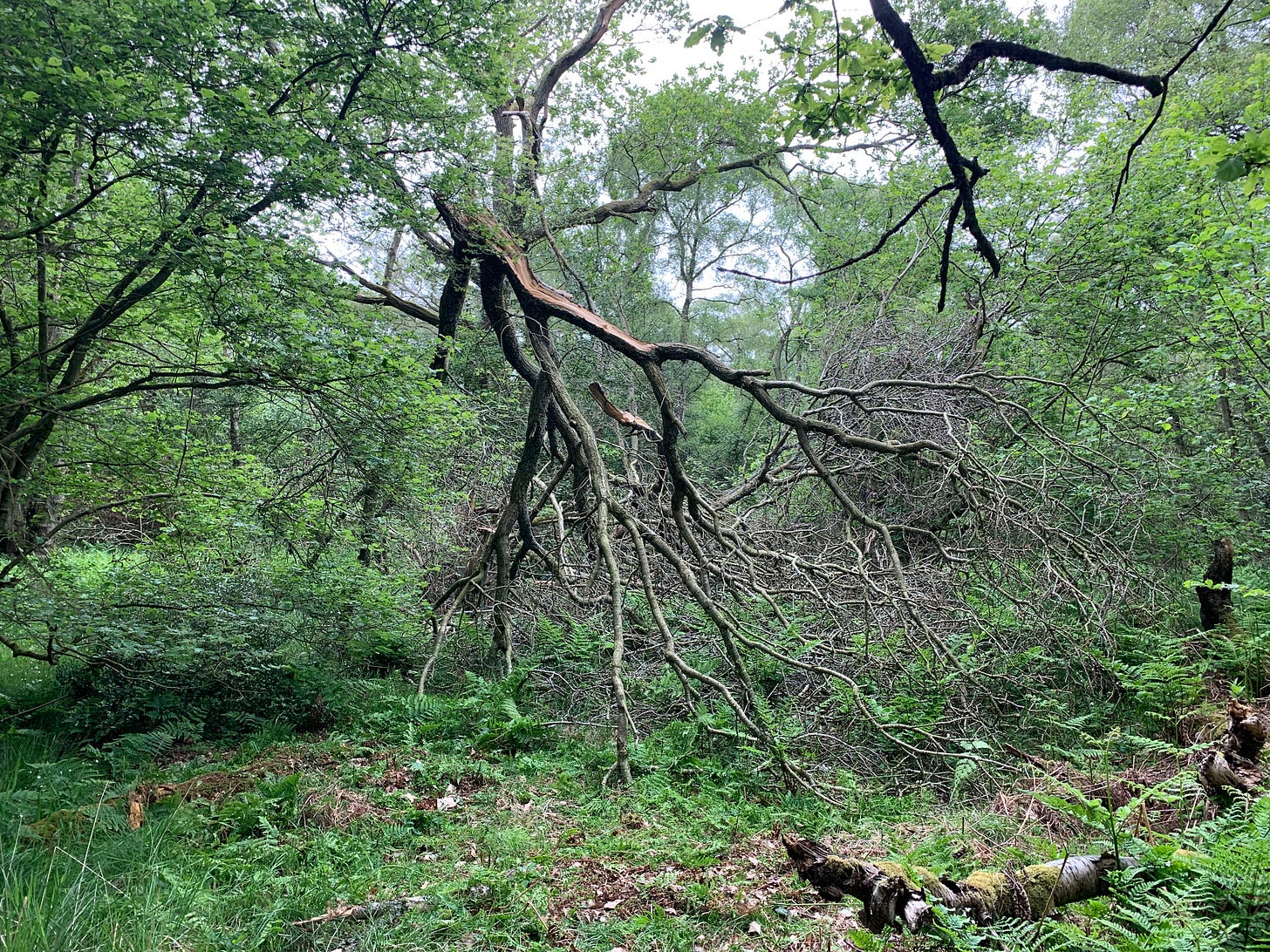
For scale, here I am underneath it.
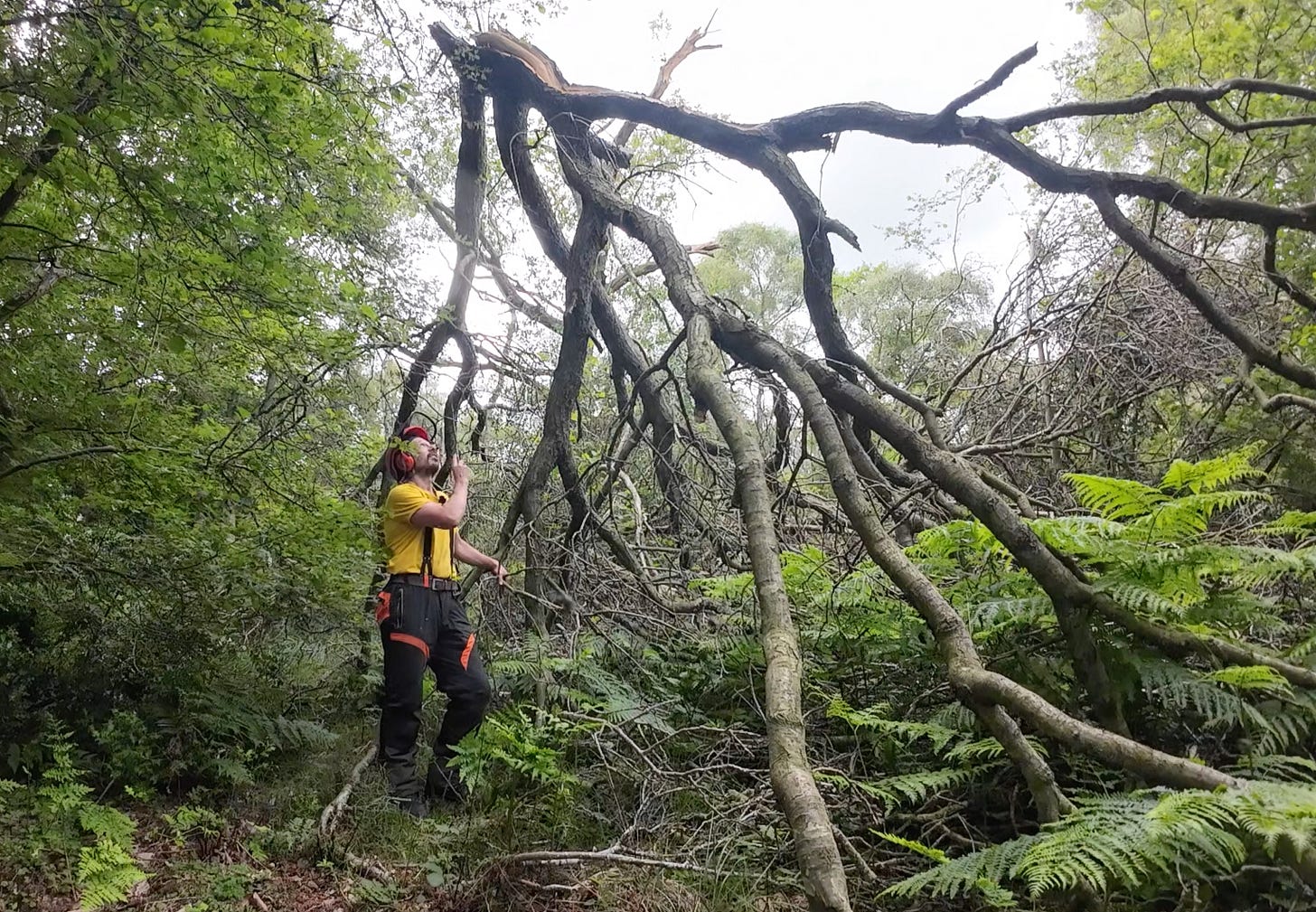
Here’s the places those limbs came off. The larger limb that forms that giant structure came from the oval in the centre, and the smaller limb came off the upper right oval.
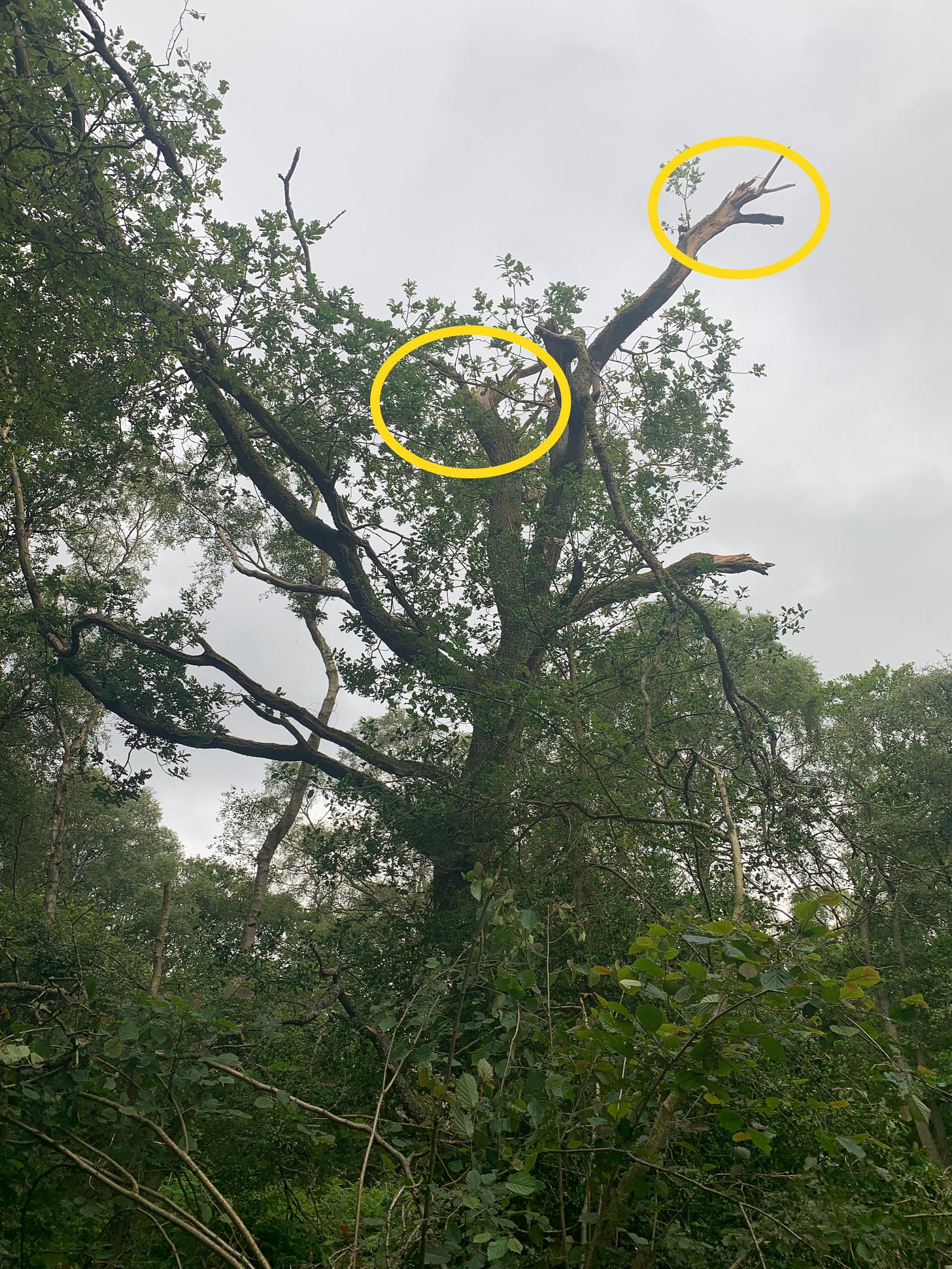
I’ll be performing some remedial works on this tree in the future, as I want the oak to survive for as long as possible. The main stem is relatively intact and it is capable of smashing out acorns that germinate as evidenced by the three saplings I’ve managed to tube up at the base of it.
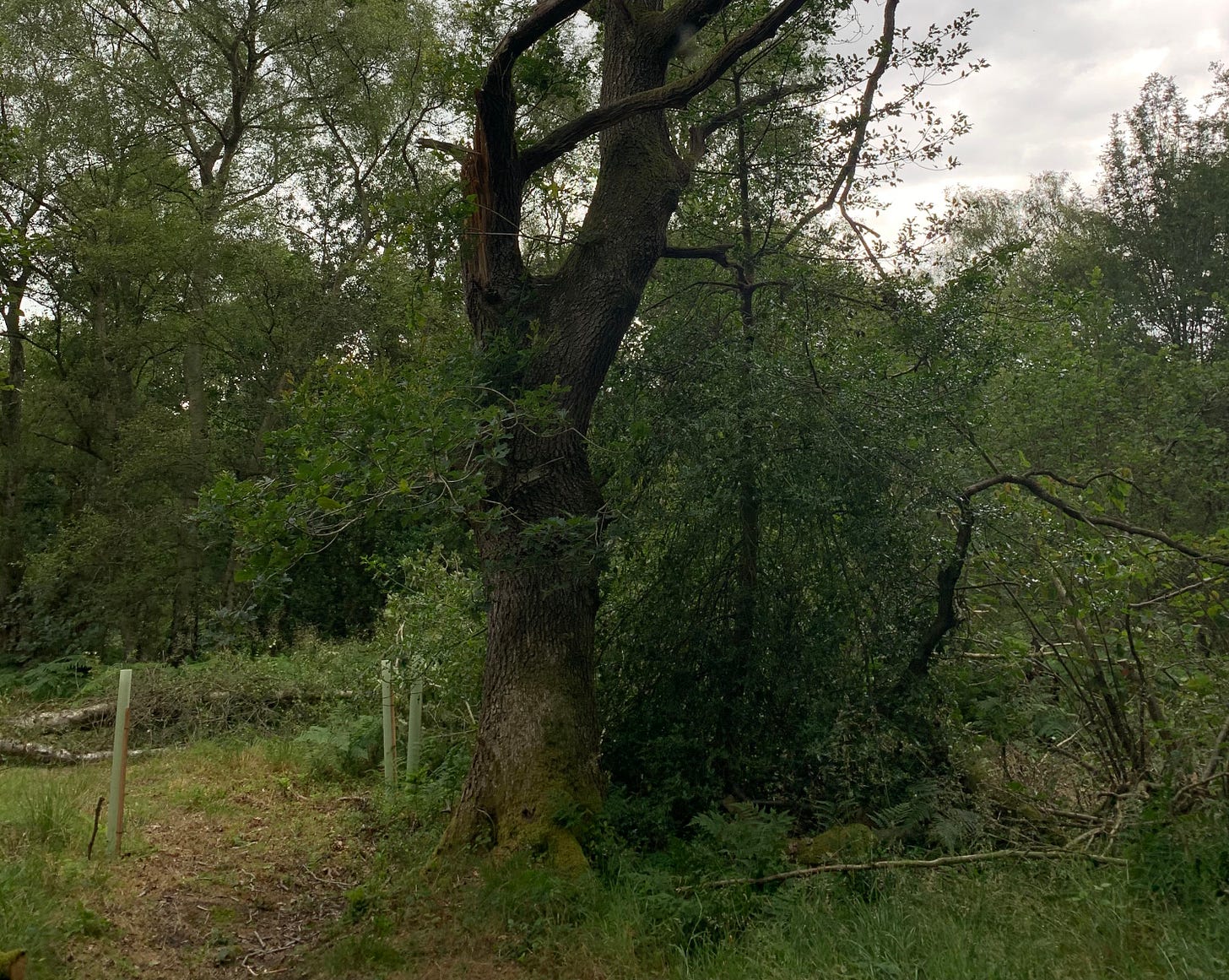
I chose to perform the dismantling on a nice day in July. If you’re sitting there thinking “ah how lovely to be in the woodland in July” then you’re right and wrong. It is a lovely place for sure, however in July the flies are legion in number. They tend to swarm around warm cameras and sweaty hardworking humans. Hundreds of flies. All the time.
The first order of business was to use the strimmer to get the bracken and grass down. Deer and bracken mean one thing - ticks. Especially in summer months. Here’s the start of the day once I’d strimmed the working area down. I don’t want to clear any more area than necessary, so I tried to strike the balance between clearing habitat and creating a reasonable work space. I think I nailed it.
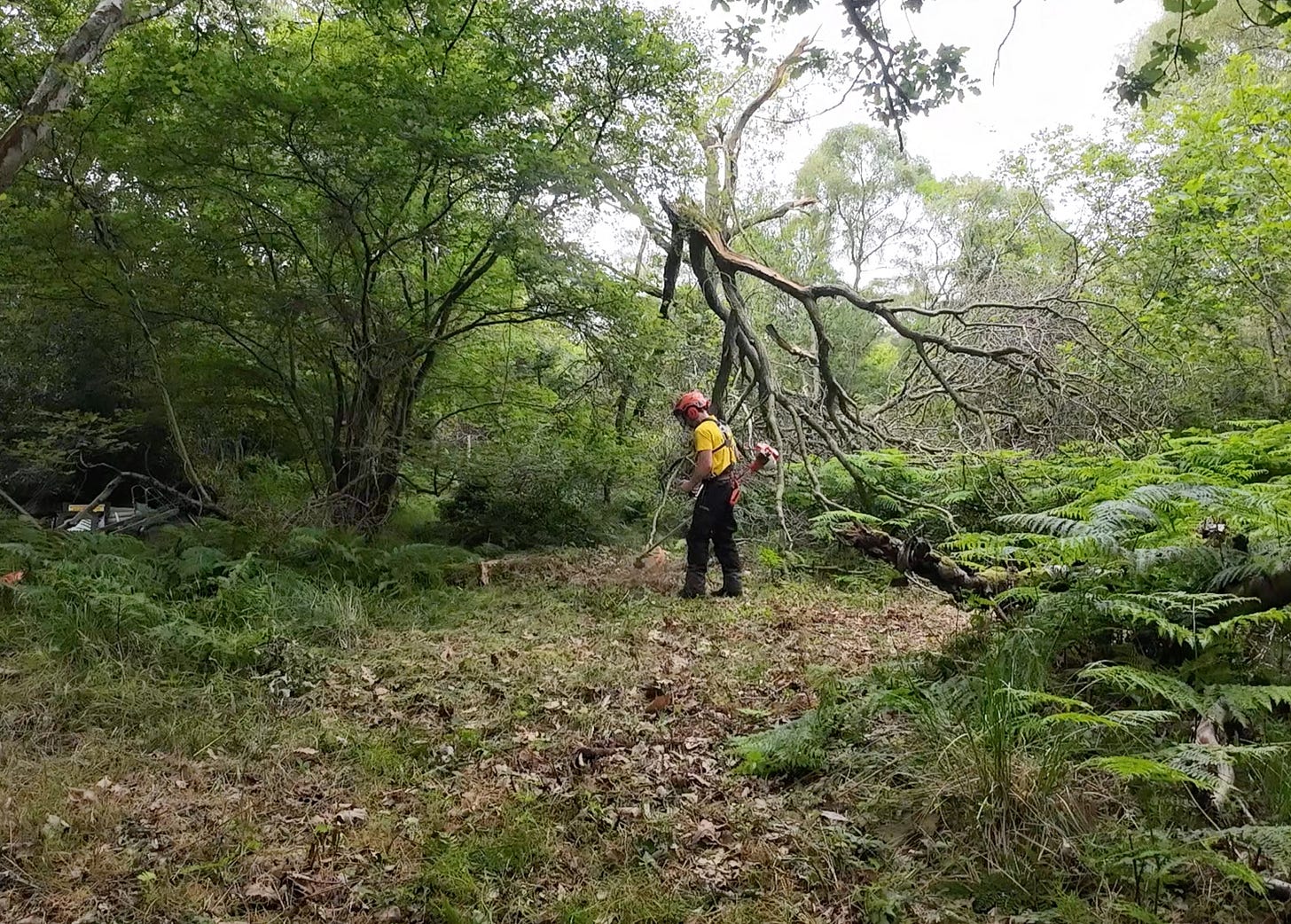
A quick word on ticks. Ticks (insects) are no laughing matter. However, neither are they something to fear. Yes, they are hard to spot once you’ve been bitten1, yes they are a pain to correctly remove once you have been bitten, and yes they can give you lymes disease and other awful diseases. However, taking the correct precautions such as applying a permethrin based clothing solution, cutting down grass and bracken and checking yourself thoroughly (especially up in the nasties) once you’re home all reduces the risk to level to a point where there’s only really fear to deal with. I use Sawyer permethrin spray and it works a treat. I’ve never been bitten when I’ve been wearing something with this on. On the five occasions I’ve been bitten by a tick, it has been when I’ve been wearing untreated stuff. As a matter of due diligence I apply it to all my arb and forestry gear. Tick management is a thing and you should practice it when in areas with high grass, bracken and livestock.
Back to trees again. The structure was in no immediate risk of falling over as it was. It had been there for a few years and it wasn’t going anywhere today. This was good as I needed to start cutting away the limbs on the inside that were not performing any structural function. I knew at some point the winch would come out to pull it over, but I wanted to get the structure where it would be easy to winch over. As it stood there was too much counterweight in it and winching may have failed. That meant I had to get into the centre of the mess and start lopping off everything that was under no structural load or tension or compression.
Eventually all of the non-structural limbs were removed.
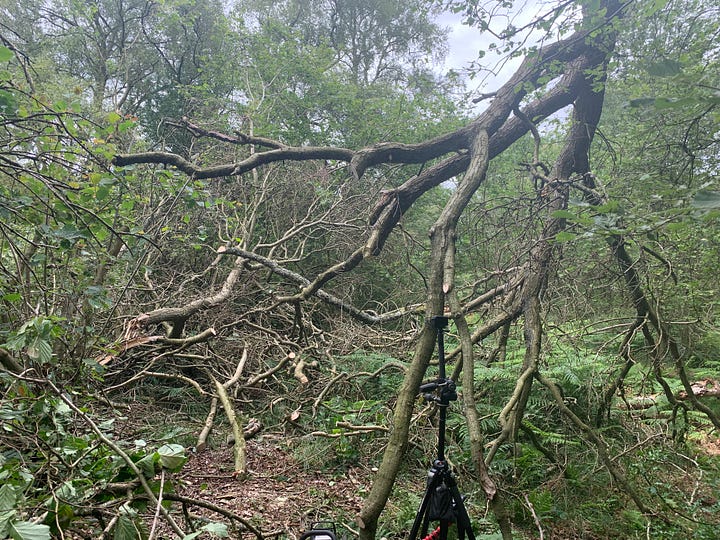
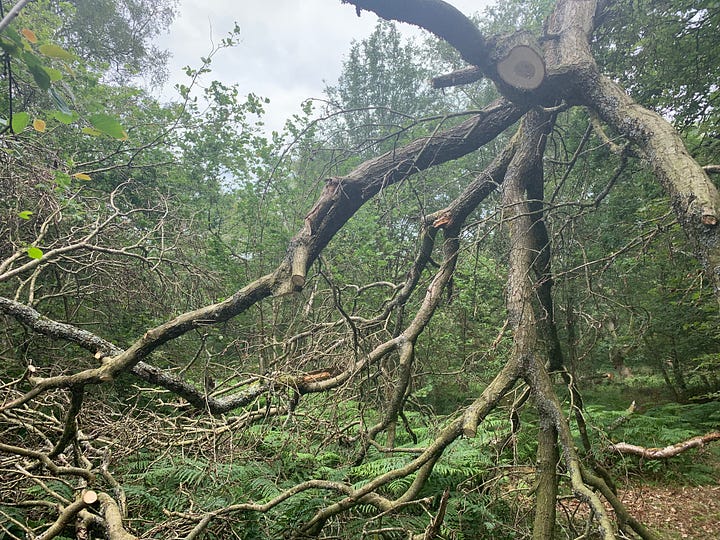
I was at the point where it was winch time. So the first thing to do was to get the strop attached. I did have to climb up onto the structure a bit, but my meagre 77kg did nothing to affect the stability of it. I’ve put the strops around the area I wanted to be the tipping point and in a basket configuration. This configuration takes a 3000kg rated strop and turns it into a 6000kg rating. You always want the weakest part of your winching system to be the brass pins in the winch, so the higher rated the upstream parts the better.
Next it was time to set the winch up on the anchor point. Luckily for me this is a woodland and one need not look far for a solid oak tree. Again, I am using a basket configuration to give me double the safe working load.
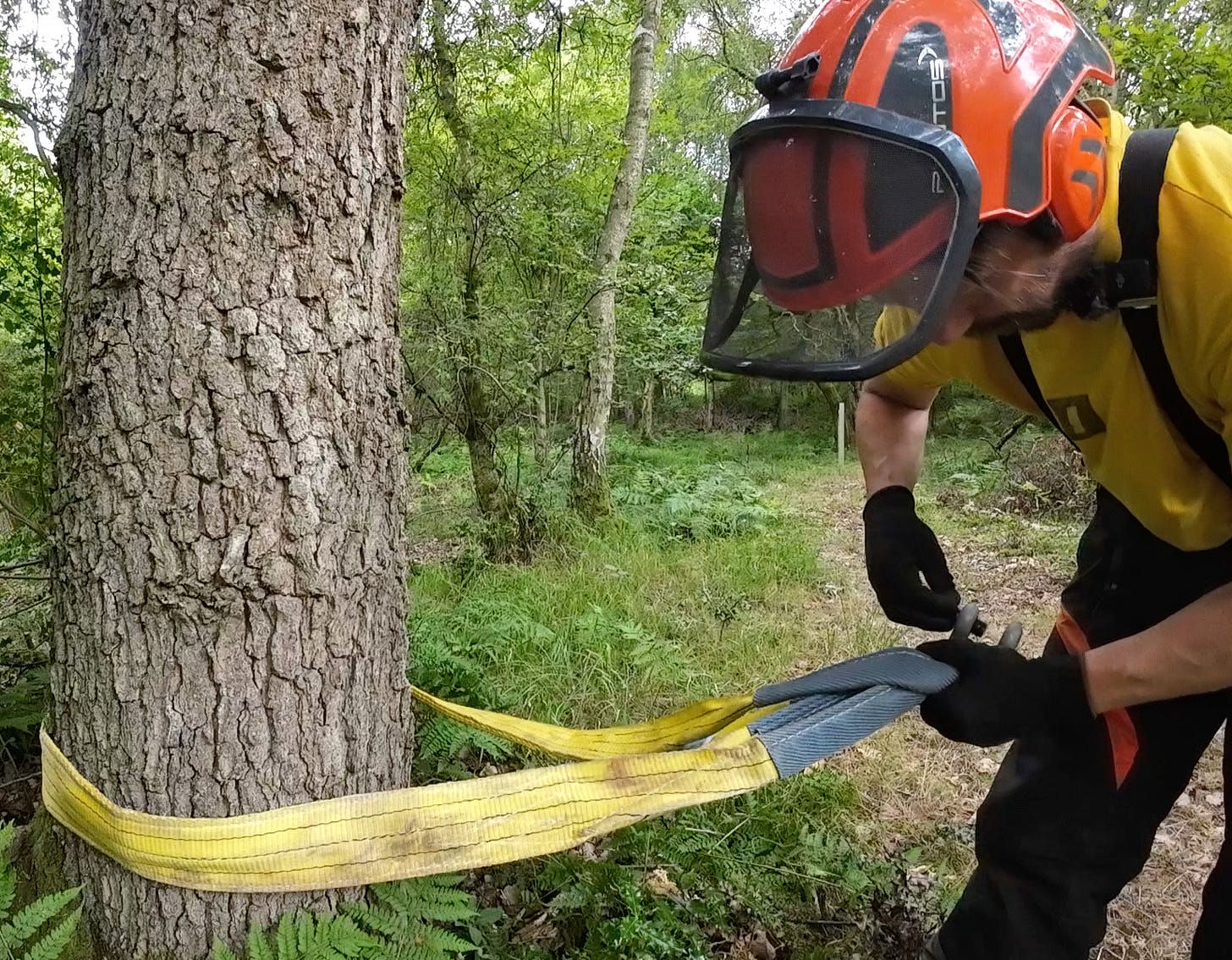
Then you feed the cable through
Then you connect your system together
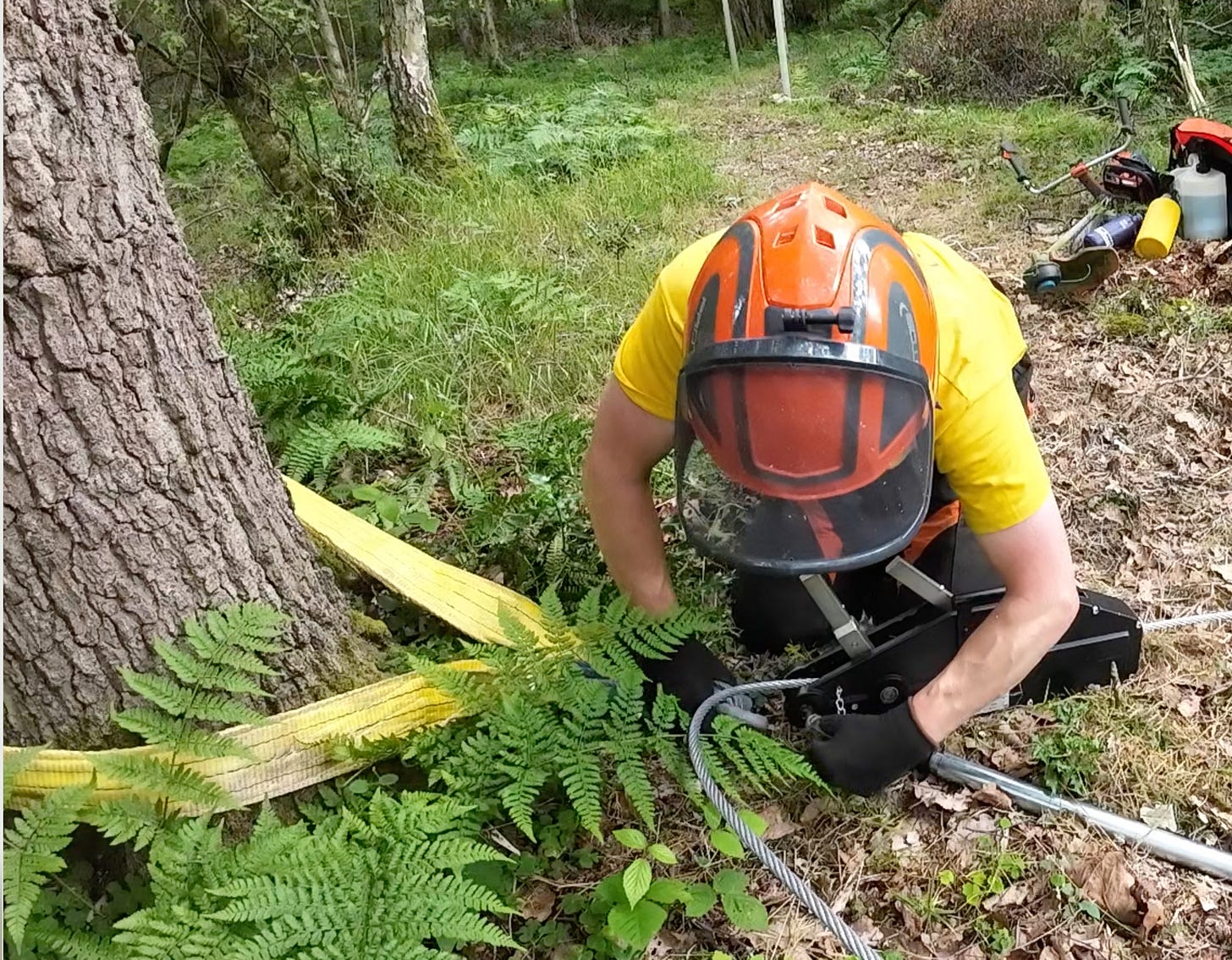
Then you crack the handle on and get winching
The line will go taught and then the thing falls over - here’s the dramatic video
Winches are so much fun and the force they exert is phenomenal. Yes they’re dangerous, but so are most things that are fun. The trick is in knowing how to safely operate them and fortunately for me, we do that at treeschool.
All in all, it took about one hour to get it on the ground. The next four hours were spent chopping it up into firewood and moving it to the firewood stash. Whilst the flies, non-stop by the way, were buzzing around me like I was a freshly laid dog turd and the horse flies were treating me as an all you can eat buffet. I think I took five direct blood producing bites on this day.

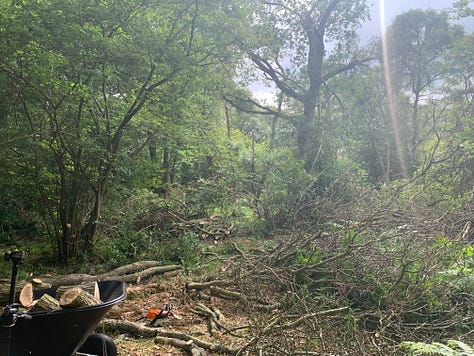
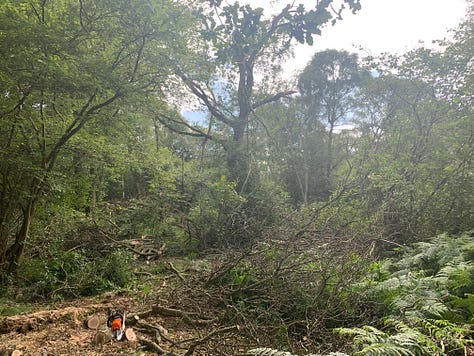


It is drummed into us at treeschool that when you’re working about 80-90% of the day will be spent moving bits of tree. It is true. I’ve lost close to 12kg of body weight since Christmas and I put that down to diet and working in woodlands on trees. It really is a kind of exercise that you don’t get in a gym. Uneven ground, uncomfortable conditions, constant cardio and weight bearing movements and psychological stresses all contribute to something I call “Forest Fit”.
The firewood stores gained a bit of fuel. They say firewood warms you three times. Once when you collect it, once when you split it and then once when you burn it. In my woodland it’s four or five times. Once when I fell it, once when I process it, once when I split it, once when I load it onto the car and then finally once when I burn it. Summer is the wrong time to do this work.
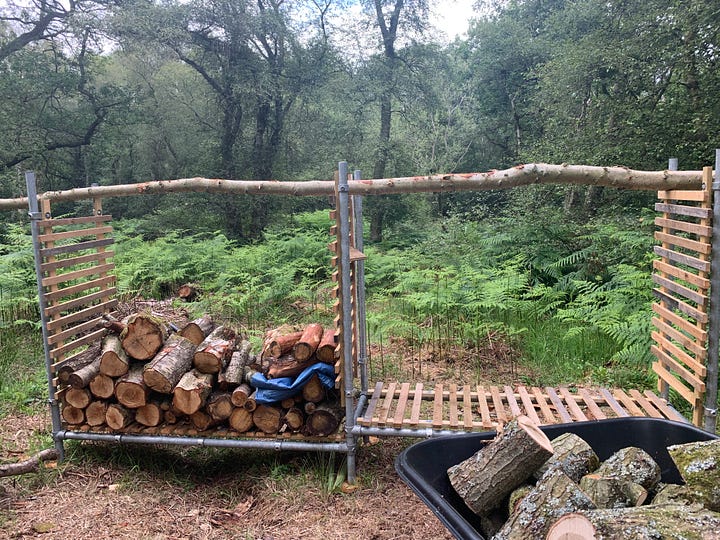
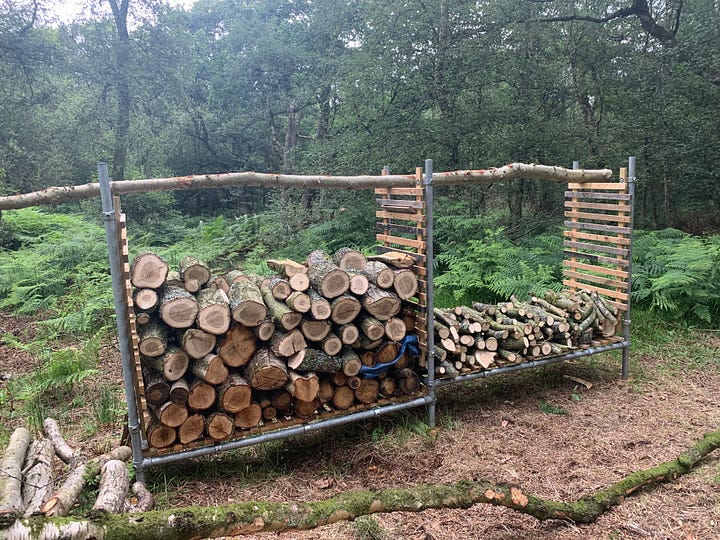
I didn’t have time, battery power or the tolerance to continue to deal with the flies and at 5:30pm I called it a day. I left a pile of wood to process into firewood and MASSIVE pile of kindling to process later. I was also sick to death of flies.
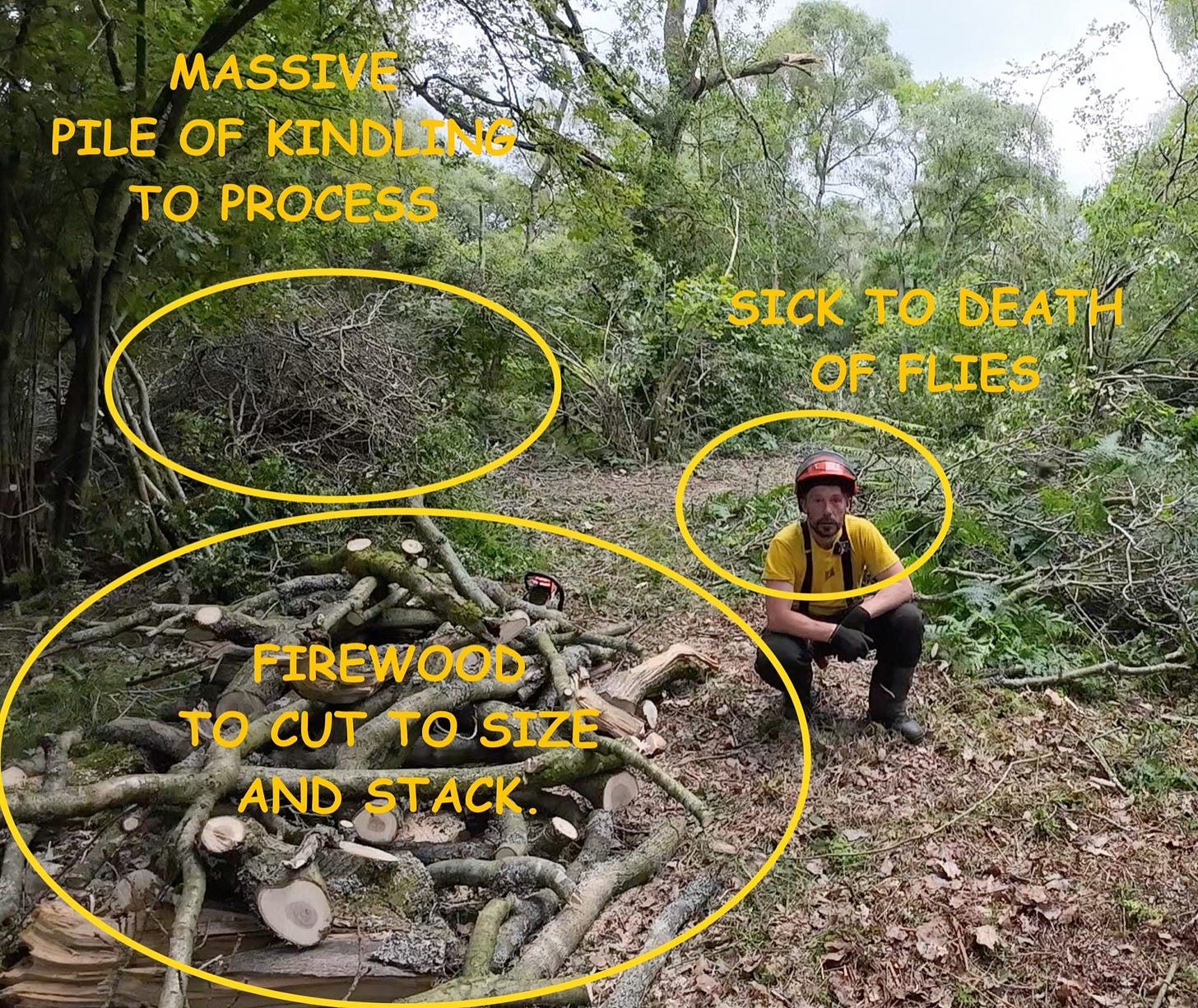
I’d love to say I’ll get that pile of kindling and wood processed soon but I suspect it’s going to stay there until September. Maybe I will do the firewood before then, but there are other jobs that need doing - the next one will be the remedial work on the oak to which these limbs were once attached. If you look closely in the background of the above picture you can see a limb on the right hand side of the stem that was recently broken off by a windfallen birch. I want to get that work done before I go on holiday.
Thanks for reading,
Cheers,
Jamie.
The ticks we have in our woodland are very small. They look like specs of dirt and if you’re not looking for them you can easily miss them. The tell tale sign is that they have a slight bump when you touch them, they don’t move on skin like dirt does and they when viewed under a magnifying glass, they are obviously blood sucking parasites that must be removed correctly and then burned alive for their crimes against you. Also, remember to take a permanent marker and draw a circle around the bite. Monitor the bite location for discolouration. If you see any over the next few days get yourself to your local drug dealer (GP) and demand antibiotics for treating lymes disease.




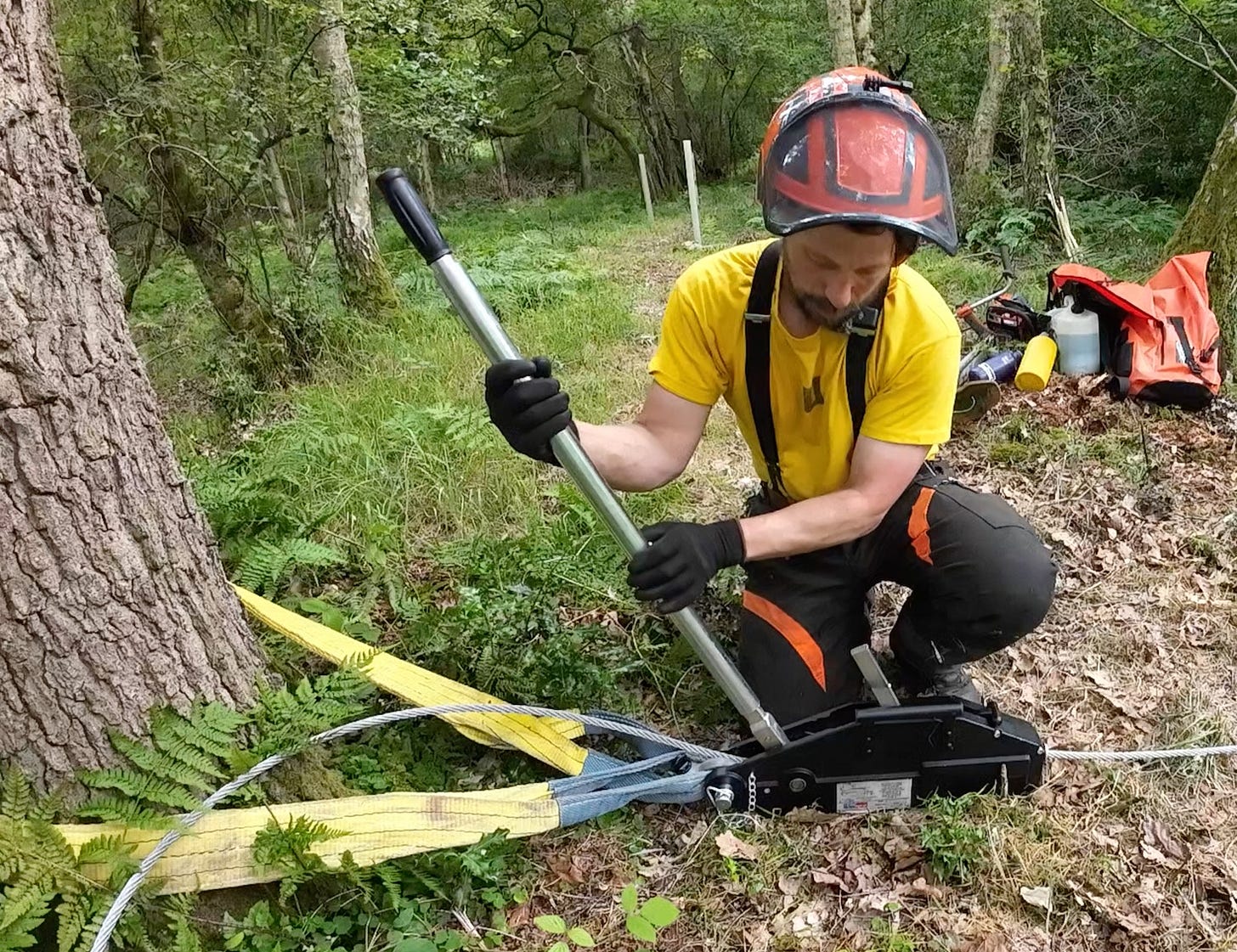
Crikey, Jamie I didn’t know there were ticks in UK … I thought it was only in hotter countries… Lots of lovely wood for the winter, it must save you a small fortune, anyway see you soon …